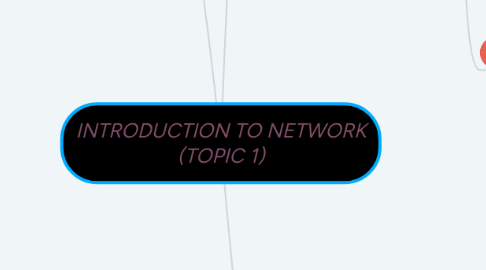
1. 1.3CREATE LAN USING LAN NETWORK
1.1. LAN Connectivity Hardware
1.1.1. Router
1.1.2. Switch
1.1.3. Wireless Access Point
1.1.4. Bridge
1.1.5. Mobile Base Stations
1.2. Network Interface Card(NIC)
1.2.1. Types of NIC
1.2.1.1. PCI
1.2.1.2. PCI Express
1.2.1.3. PCMCIA Adapter
1.2.1.4. USB Port
1.2.1.5. Firewire
1.2.1.6. Compact Flash NIC
1.2.1.7. On-Board NIC
1.2.1.8. Wireless NIC
1.3. Data Transmission Mode
1.3.1. Modes
1.3.1.1. Simplex
1.3.1.2. Half-Duplex
1.3.1.3. Full-Duplex
1.4. Virtual Local Area Network(VLAN)
1.4.1. Adavantages
1.4.1.1. Ease To Administration
1.4.1.2. Broadcast Control
1.4.1.3. Reduced Cost
2. 1.1 : IMPLEMENT THE BASIC CONCEPT OF COMPUTER NETWORKS
2.1. What is Network ?
2.1.1. A combination of computer hardware , cabling , network device and computer software that allows computers to communicate with each other .
2.2. Advantages
2.2.1. Data exchange
2.2.2. Hardware Resource Sharing
2.2.3. Software Resource Sharing
2.2.4. Data security
2.2.5. Increased Communication Capabilities
2.2.6. Entertainment
2.2.7. BACKUP-Avoid file duplication and corruption
2.3. Types of Network
2.3.1. Peer-to-peer (P2P)
2.3.1.1. Perform similar tasks , sharing of resources
2.3.1.2. Located in the same geographical area
2.3.1.3. Advantage of P2P
2.3.1.3.1. Less initial expense
2.3.1.3.2. Setup
2.3.1.4. Disadvantages of P2P
2.3.1.4.1. Decentrralized
2.3.1.4.2. Security
2.3.2. Client server
2.3.2.1. Multiple computer or device connected to a sever to perform any network activities
2.3.2.2. Advantgaes of CS
2.3.2.2.1. Centralized
2.3.2.2.2. Security
2.3.2.2.3. Flexibility
2.3.2.2.4. Interoperability
2.3.2.2.5. Accesibility
2.3.2.3. Disadvantages of CS
2.3.2.3.1. Expense
2.3.2.3.2. Maintenance
2.3.2.3.3. Dependence
2.4. Category network
2.4.1. Local-area network (LAN)
2.4.2. Wide-area network (WAN)
2.4.3. Metropolitan-area network (MAN)
2.5. Element of Client server network
2.5.1. Client
2.5.2. Server
2.5.3. Network interface card
2.5.4. Network operating system
2.5.5. Backbone
2.5.6. Segment
2.5.7. Topology
2.5.8. Transmission media
2.6. Network of topologies
2.6.1. PHYSICAL
2.6.2. LOGICAL
2.6.3. Network topologies
2.6.3.1. Bus
2.6.3.2. Ring
2.6.3.3. Star
2.6.3.4. Hybrid
2.6.3.5. Tree/Hirarchical
2.6.3.6. Mesh
3. 1.2 : PRINCIPAL OF COMMUNICATION TO NETWORKING
3.1. Data Communication System Elements
3.1.1. Data Elements
3.1.1.1. Message
3.1.1.2. Sender
3.1.1.3. Receiver
3.1.1.4. Medium
3.1.1.5. Protocol
3.1.2. Communication Devices
3.1.2.1. A hardware component that enables a computer to send & receive data from 1 or more computers
3.1.2.2. Type
3.1.2.2.1. Wired ( Data Terminal Equipment ) DTE
3.1.2.2.2. Wireless ( 3G, GPRS, Laptop, Mobile Phone )
3.1.3. Electronic Communication Methods
3.1.3.1. Fax
3.1.3.2. Email
3.1.3.3. Instant Messenger
3.1.3.4. Telephone/Mobiles
3.1.3.5. Video Conferencing
3.1.3.6. Intranet
3.1.3.7. Chat/IRC
3.1.4. Transmission Media
3.1.4.1. Guided Media
3.1.4.1.1. Twisted-Pair Cable
3.1.4.1.2. Coaxial Cable
3.1.4.1.3. Fiber Optic Cable
3.1.4.2. Unguided Media : Wireless
3.2. Transmission Flaws
3.2.1. FLAW is any defect that can affect the quality of data signal send in networking.
3.2.2. Most common flaws is
3.2.2.1. Noise
3.2.2.2. Attenuation
3.2.2.3. Latency
3.2.3. Radio frequency interference (RFI)
3.2.3.1. Generated by motors, power,televisions,copiers,fluorescent lights or broadcast signals from radio or TV towers
3.2.4. Electromagnetic interference (EMI)
3.2.4.1. Be caused by motors, power lines or other sources of electrical activity
3.2.5. Regeneration
3.2.5.1. Process of retransmitting a digital signal
3.2.6. Repeater
3.2.6.1. Device used to generate a signal

